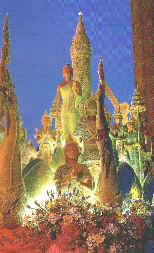|
|
Court culture refers to the conception of beauty, perfection and harmony in fine arts, including painting, sculpture, architecture, literature, drama and music. In the old days, most of these originated in or received the patronage of royal court and nobility. Most of the works served Buddhist religion. Their styles were influenced by Indian through Mon and Khmer, and then were blended and developed in unique forms recognized as Thai.
Painting
Classical Thai painting is mostly confined to mural painting inside Buddhist temples and places. They are idealistic and themes frequently depicted are those related to Buddhism, such as Buddha's life stories, stories of 3 worlds (heaven, earth and hell), and also those concerning customs and traditions. Subjects of the painting reflect different purposes: To beauty and dignify the places of worship, to promote Buddhism and to educate people through pictures.
Architecture
Apart from royal palace buildings, classical Thai architecture can be found in monastic monuments, pagodas and temples, which have been the focal points of Thai community activities for centuries. Admitting Indian, Khmer and other influences, such as Chinese and Burmese, Thai architects developed their own distinctive style of sloping multitiered roof-tops and soaring printed towers, intricately ornamented with carved wood and stucco, gilded lacquer work. mother-of-pearl inlay, Chinese porcelain fragments and color glass mosaic. Under tropical sun, these buildings gave out artistic harmony of flamboyance and serenity. Examples of Thai architecture are seen in Wat Phra Kaeo, Wat Pho, Wat Suthat, Grand Palace,...
Sculpture
Thai sculpture is concentrated on Buddha images that rank among the world's greatest expressions of Buddhist art. As a result, it is widely believed that Buddha images in Thailand, from Chiang Saen Period (11-13th century) to the present Rattanakosin or Bangkok Period, are so numerous that they far outnumber the population of the country. These sculptures are made in wood, metal, ivory, precious stones and stucco and have been created to represent Ratanartai of Buddhism, i.e., Buddha, Dhamma (Buddha's doctrine) and Sanga (Buddhist clergy). Among the most beautiful Buddha images in Thailand are Phra Buddha Chinnarat in Wat Mahathat (Phistanulok province) and Phra Buddha Chinnasi in Wat Bowon Niwet (Bangkok).
Literature
In the early days, Thai literature was concerned with religion, royalty and aristocracy and hardly anything else. They were written in verse of various patterns. Then, in the early 20th century, King Rama VI made revolution in Thai literary history. Prose has become favorite form of writing among Thai writers since then, and common files scenes have been depicted in their works. One of the most important Thai literary pieces in Ramakian, an epic derived from "Ramayana" of India.
Drama
In the purely classical form, Thai drama and dance are indivisible. Techniques of dancing are of Indian origin, but Thai people evolved them to be much more graceful and slow in motion. Thai dramas include renowned Khon (masked drama), Lakhon (less formal dance drama with movements more graceful than Khon), Nang Yai and Nang Talung (shadow plays) and Hun (marionettes). In former days, dramas were normally performed only in royal courts and noble mansions. Ordinary people could enjoy such performances only on festive occasions in compound of Buddhist monastery.
Music
Thai classical music uses the diatonic music scale. The instruments are of four kinds: Those of plucking, drawing, percussion and woodwind. Apart from drama, Thai classical music is played in some religious ceremonies, traditional rites and on festive occasions.

|
|

